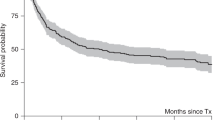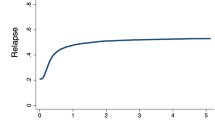Summary:
The aim of this study was to identify trends in high-dose chemotherapy (HDC) with autologous hematopoietic stem cell transplantation (ASCT) and to assess survival in a large cohort of breast cancer (BC) patients receiving this therapy in Europe from 1990 to 1999. A total of 7471 patients who received HDC with ASCT between January 1, 1990 and December 31, 1999 were reported to the European Group for Blood and Marrow Transplantation Registry. Data required for demographics and survival analysis were available for 2679 patients with high-risk primary BC; 921 patients with inflammatory BC (IBC), and 2295 patients with metastatic disease. The main evaluation parameters were progression-free survival (PFS) and overall survival (OS). Between 1990 and 1998, autotransplants for BC increased 30-fold. Significant trends included use of blood-derived rather than marrow-derived stem cells, increment of reporting centers and decrease of mortality within 100 days from transplantation. The 5-year PFS and OS probabilities were 53 and 68% for high-risk disease and 42 and 53% for IBC, respectively. For metastatic disease 5-year PFS and OS probabilities in the whole cohort were 18 and 27%, respectively, while for women transplanted in complete remission the 5-year PFS was 29%. In conclusion, HDC with ASCT has been increasingly used until 1998 and the 100-day mortality rate has been constantly less than 2% from 1995 to date. The 5-year survival of high-risk BC is related to the number of axillary nodes involved at surgery. Outcome of patients with IBC is encouraging, suggesting the need for randomized trials. Patients with metastatic disease responding to pretransplant chemotherapy and harboring ER+ tumors have a better outcome.
This is a preview of subscription content, access via your institution
Access options
Subscribe to this journal
Receive 12 print issues and online access
$259.00 per year
only $21.58 per issue
Buy this article
- Purchase on Springer Link
- Instant access to full article PDF
Prices may be subject to local taxes which are calculated during checkout


Similar content being viewed by others
References
Winer EC, Morrow M, Osborne CK, Harris JR . Malignant tumors of the breast. In: DeVita Jr VT, Hellman S, Rosenberg SA (eds). Cancer: Principles and Practice of Oncology. Lippincott-Raven: Philadelphia, PA, 2001, pp. 1651–1716.
Greenberg PA, Hortobagyi GN, Smith TL et al. Long-term follow-up of patients with CR following combination chemotherapy for metastatic breast cancer. J Clin Oncol 1996; 14: 2197–2205.
Skipper HE . Dose intensity versus total dose of chemotherapy: an experimental basis. In: De Vita VT, Hellman S, Rosenberg SA (eds). Important Advances in Oncology. Lippincott-Raven: Philadelphia, PA, 1990, pp. 43–64.
Lazarus HM . Hematopoietic progenitor cell transplantation in breast cancer: current status and future directions. Cancer Invest 1998; 16: 102–126.
Crown J . High-dose chemotherapy of metastatic breast cancer: the end of the beginning? Br J Cancer 1997; 75: 467–479.
Gianni AM, Siena S, Bregni M et al. Granulocyte-macrophage colony-stimulating factor to harvest circulating haemopoietic stem cells for autotransplantation. Lancet 1989; 2: 580–585.
Siena S, Bregni M, Brando B et al. Circulation of CD34+ hematopoietic stem cells in the peripheral blood of high-dose cyclophosphamide-treated patients: enhancement by intravenous recombinant human granulocyte–macrophage colony-stimulating factor. Blood 1989; 74: 1905–1914.
Schmitz N, Linch DC, Dreger P et al. Randomized trial of filgrastim-mobilized peripheral blood progenitor cell transplantation versus autologous bone-marrow transplantation in lymphoma patients. Lancet 1996; 347: 353–357.
Siena S, Schiavo R, Pedrazzoli P, Carlo-Stella C . Therapeutic relevance of CD34 cell dose in blood cell transplantation for cancer therapy. J Clin Oncol 2000; 18: 1360–1377.
Neymark N, Rosti G : Patient management strategies and transplantation techniques in European stem cell transplantation centers offering breast cancer patients high-dose chemotherapy with peripheral blood stem cell support: a joint report from the EORTC and EBMT. Haematologica 2000; 85: 733–744.
Stadtmauer EA, O'Neill A, Goldstein LJ et al. Conventional-dose chemotherapy compared with high-dose chemotherapy plus autologous hematopoietic stem-cell transplantation for metastatic breast cancer. N Engl J Med 2000; 342: 1069–1076.
Crump M, Gluck S, Stewart D et al. A randomized trial of high-dose chemotherapy (HDC) with autologous peripheral blood stem cell support (ASCT) compared to standard therapy in women with metastatic breast cancer: a National Cancer Institute of Canada (NCIC) Clinical Trials Group Study. J Clin Oncol 2001; 20: 21a (Abstr).
Bergh J, Wiklund T, Erikstein B et al. Tailored fluorouracil, epirubicin, and cyclophosphamide compared with marrow-supported high-dose chemotherapy as adjuvant treatment for high-risk breast cancer: a randomised trial. Scandinavian Breast Group 9401 study. Lancet 2000; 356: 1384–1391.
Peters W, Rosner G, Vrendeburgh J et al. Updated results of a prospective, randomized comparison of two doses of combination alkylating agents as consolidation after CAF in high-risk primary breast cancer involving ten or more axillary lymph nodes: CALBG 9082/SWOG 9114/NCIC Ma. 13. J Clin Oncol 2001; 20: 21a (Abstr).
Gianni A, Bonadonna G . Five-year results of the randomized clinical trial comparing standard versus high-dose myeloablative chemotherapy in the adjuvant treatment of breast cancer with >3 positive nodes. J Clin Oncol 2001; 20: 21a (Abstr).
Gianni L : High-dose chemotherapy for breast cancer: any use for it. Ann Oncol 2002; 13: 650–652.
Pedrazzoli P, Siena S . Clinical results in 2001 show high dose therapy and hematopoietic progenitor cell transplantation as a therapeutic option for breast cancer. Haematologica 2001; 86: 900–907.
Berry DA, Broadwater G, Klein JP et al. High-dose versus standard chemotherapy in metastatic breast cancer: comparison of cancer and leukemia group B trials with data from the autologous blood and marrow transplant registry. J Clin Oncol 2002; 20: 743–750.
Gratwohl A, Hermans J . Bone marrow transplantation activity in Europe 1992: report from the European Group for Bone Marrow Transplantation (EBMT). Bone Marrow Transplant 1994; 13: 5–10.
Gratwohl A, Passweg J, Baldomero H, Urbano-Hispizua A . European Group for Blood and Marrow Transplantation (EBMT), hematopoietic stem cell transplantation activity in Europe 1999. Bone Marrow Transplant 2001; 27: 899–916.
Kaplan EL, Meier P . Nonparametric estimation from incomplete observations. J Am Stat Assoc 1958; 53: 457–481.
Cox DR . Regression models and life tablets. J R Stat Soc B 1972; 3: 187–202.
Antman KH, Rowlings PA, Vaughn WP et al. High-dose chemotherapy with autologous hematopoietic stem-cell support for breast cancer in North America. J Clin Oncol 1997; 15: 1870–1879.
Siena S, Bregni M, Di Nicola M et al. Durability of hematopoiesis following autografting with peripheral blood hematopoietic progenitors. Ann Oncol 1994; 5: 935–941.
Stadtmauer EA, O'Neill A, Goldstein LJ et al. Conventional-dose chemotherapy with high-dose chemotherapy plus autologous stem cell transplantation for metastatic breast cancer: 5-year update of the Philadelphia trial. J Clin Oncol 2002; 21: 43a (Abstr).
Rodenhuis S, Bontenbal M, Beex L et al. Randomized phase III study of high-dose chemotherapy with cyclophosphamide, thiotepa and carboplatin in operable breast cancer with 4 or more axillary lymph nodes. J Clin Oncol 2000; 19: 74a (Abstr).
Crown JP, Lind M, Gould A et al. High dose chemotherapy with autograft (PBP) support is not superior cyclophosphamide, methotrexare and FU following doxorubicin induction in patients with breast cancer and 4 or more involved axillary lymph nodes: the anglo-celtic I study. J Clin Oncol 2002; 21: 42a (Abstr).
Zander AR, Kruger W, Kroger N et al. High-dose chemotherapy with autologous hematopoietic stem-cell support (HSCS) vs. standard dose chemotherapy in breast cancer patients with 10 or more positive lymph nodes: first result of a randomized trial. J Clin Oncol 2002; 21: 415a (Abstr).
Jaiyesimi IA, Buzdar AU, Hortobagyi G . Inflammatory breast cancer: a review. J Clin Oncol 1992; 10: 1014–1024.
Thomas F, Arriagada R, Spielmann M et al. Pattern of failure in patients with inflammatory breast cancer treated by alternating radiotherapy and chemotherapy. Cancer 1995; 76: 2286–2290.
Viens P, Penault-Llorca F, Jacquemier J et al. High-dose chemotherapy and haematopoietic stem cell transplantation for inflammatory breast cancer: pathologic response and outcome. Bone Marrow Transplant 1998; 21: 249–254.
Rowlings PA, Williams SF, Antman KH et al. Factors correlated with progression-free survival after high-dose chemotherapy and hematopoietic stem cell transplantation for metastatic breast cancer. JAMA 1999; 282: 1335–1343.
Hortobagyi GN . Can we cure limited metastatic breast cancer? J Clin Oncol 2002; 20: 620–623.
Lotz JP, Cure H, Janvier M et al. High dose chemotherapy with hematopoietic stem cell transplantation for metastatic breast cancer: results of the French protocol PEGASE 04. J Clin Oncol 1999; 18: 43a (Abstr).
Acknowledgements
We are grateful to the EBMT London office and to all investigators in EBMT centers who made this study possible by providing clinical data to the EBMT Solid Tumor Registry.
Author information
Authors and Affiliations
Consortia
Corresponding author
Rights and permissions
About this article
Cite this article
Pedrazzoli, P., Ferrante, P., Kulekci, A. et al. Autologous hematopoietic stem cell transplantation for breast cancer in Europe: critical evaluation of data from the European Group for Blood and Marrow Transplantation (EBMT) Registry 1990–1999. Bone Marrow Transplant 32, 489–494 (2003). https://doi.org/10.1038/sj.bmt.1704153
Received:
Accepted:
Published:
Issue Date:
DOI: https://doi.org/10.1038/sj.bmt.1704153
Keywords
This article is cited by
-
Long-term survival in a fraction of patients with metastatic breast cancer who received consolidation therapy with high-dose chemotherapy and autologous stem cell transplant between 2000 and 2015: an EBMT registry-based study
Bone Marrow Transplantation (2022)
-
A review of infectious complications after haploidentical hematopoietic stem cell transplantations
Infection (2017)
-
Current treatment strategies in relapsed/refractory mantle cell lymphoma: where are we now?
International Journal of Hematology (2017)
-
Long-term survival in patients with metastatic breast cancer receiving intensified chemotherapy and stem cell rescue: data from the Italian registry
Bone Marrow Transplantation (2013)
-
Pegase 03: a prospective randomized phase III trial of FEC with or without high-dose thiotepa, cyclophosphamide and autologous stem cell transplantation in first-line treatment of metastatic breast cancer
Bone Marrow Transplantation (2008)



